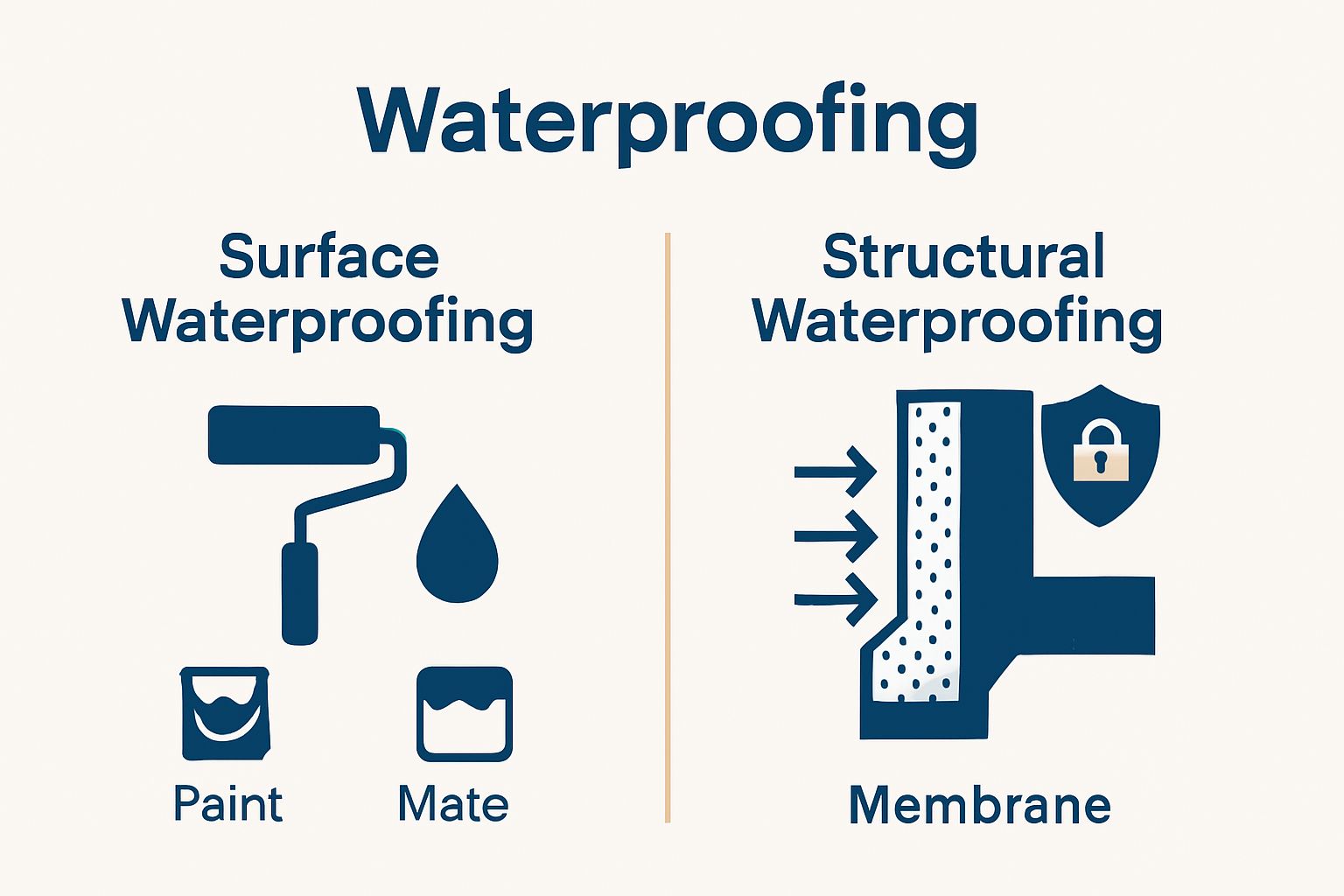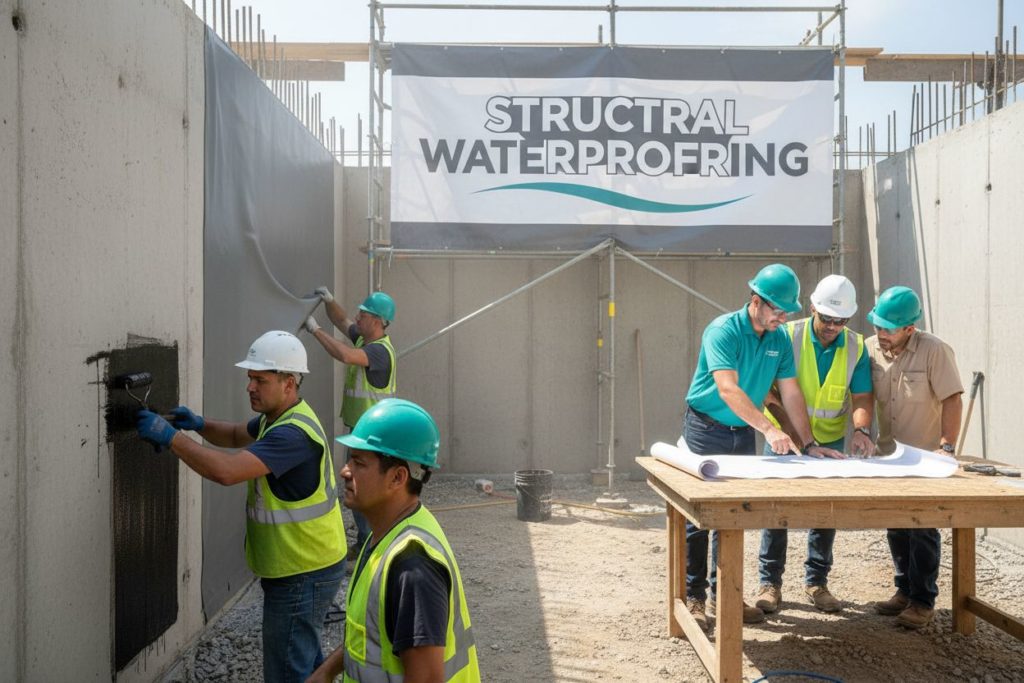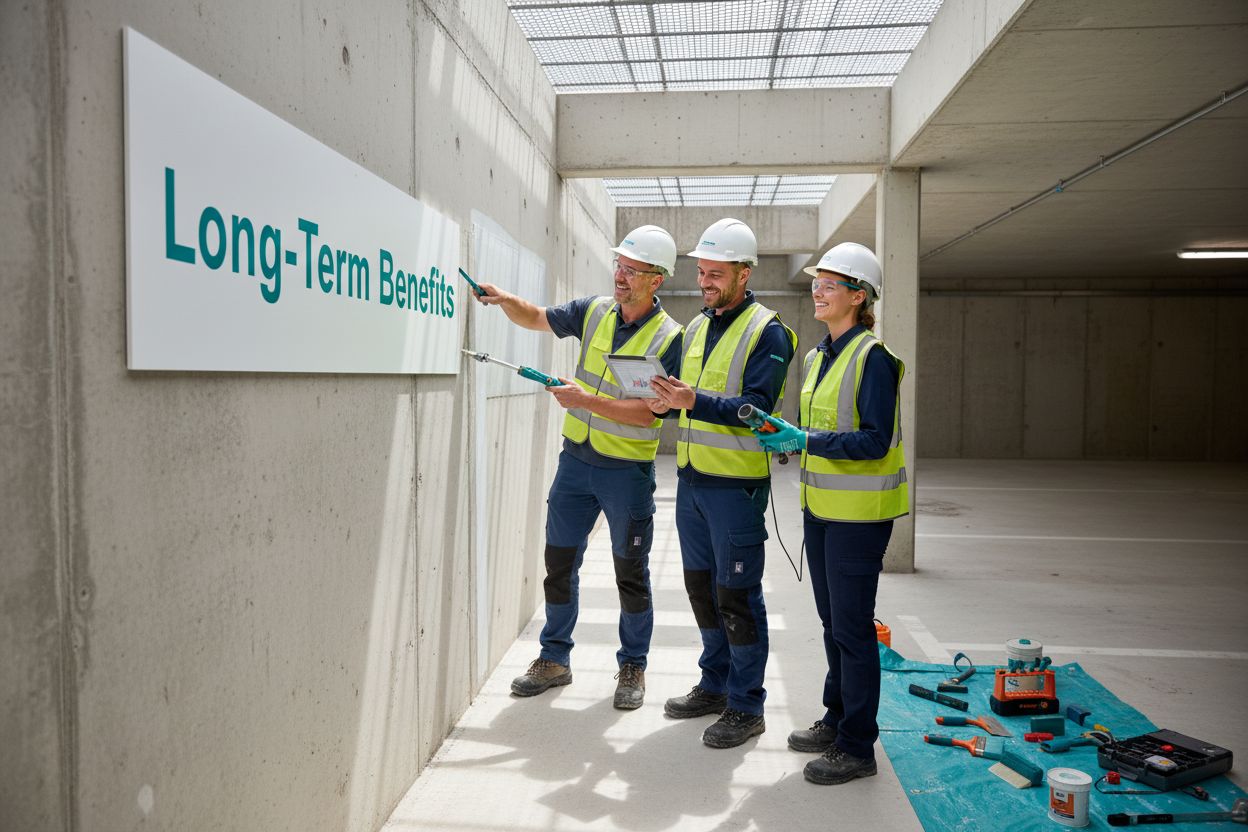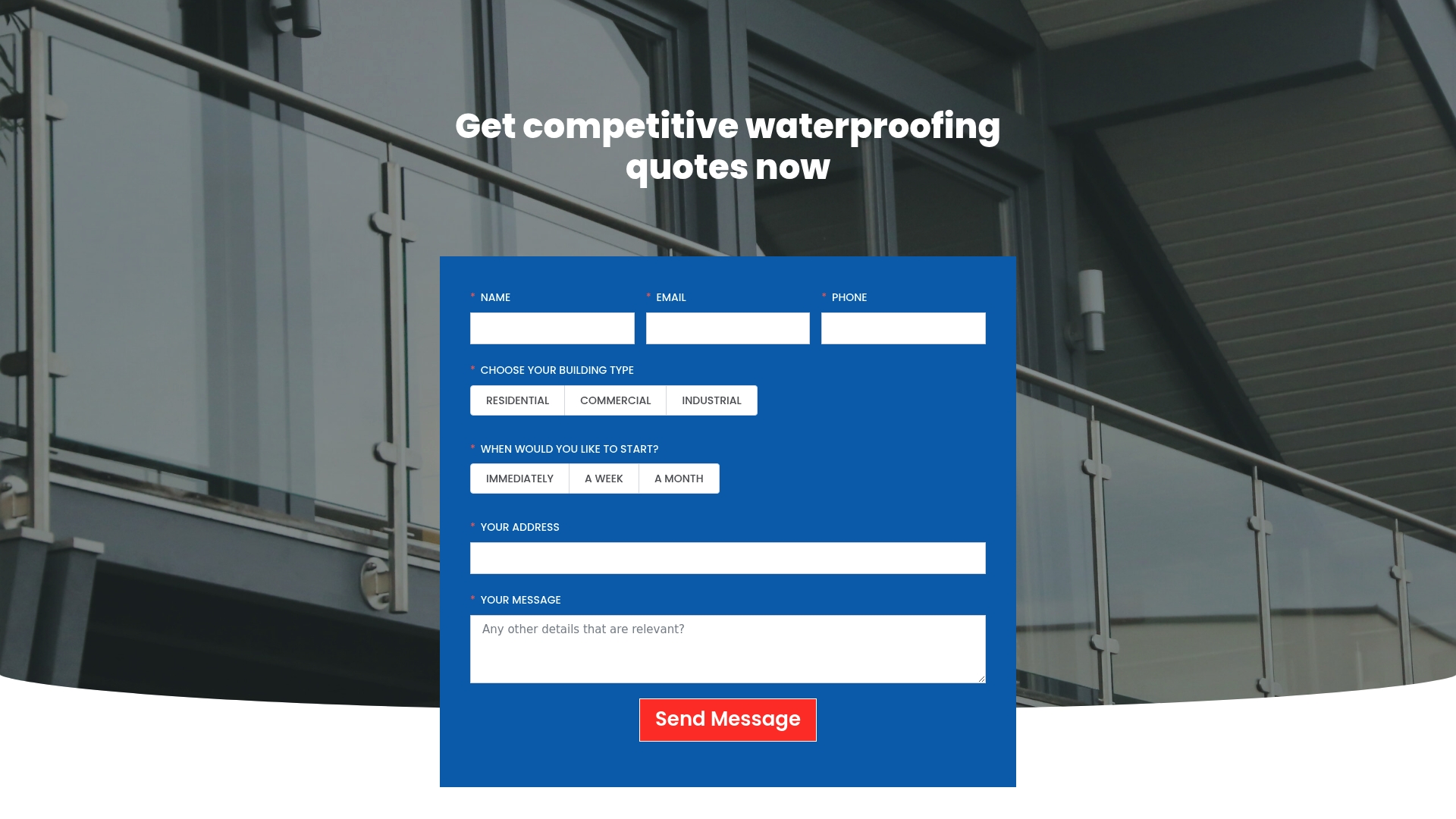Structural waterproofing is the silent defender of modern buildings, keeping out water where it matters most. Most people assume a coat of paint or a simple sealant is enough, but the real story is different. Up to 90 percent of building defects are caused by water penetration at the structural level, not by surface issues. Discover why addressing water where your building meets the ground changes everything.
Table of Contents
- Defining Structural Waterproofing: Key Concepts
- The Importance of Structural Waterproofing for Buildings
- How Structural Waterproofing Works in Practice
- Common Methods and Materials Used in Waterproofing
- Real-World Applications and Case Studies in Waterproofing
Quick Summary
| Takeaway | Explanation |
|---|---|
| Structural waterproofing is essential for integrity. | Protects critical structural elements from water infiltration, ensuring long-term stability and performance of buildings. |
| Inadequate waterproofing leads to costly damage. | Water infiltration can cause serious issues such as foundation weakening, corrosion, and mould growth, resulting in extensive repair costs. |
| Specialised materials create effective barriers. | Advanced techniques like membranes and chemical treatments are designed to block moisture and prevent structural degradation. |
| Proactive measures save future expenses. | Implementing structural waterproofing can significantly reduce maintenance needs and preserve property value over time. |
| Tailored strategies address specific challenges. | Professional assessments ensure waterproofing methods are customised to meet unique building and environmental conditions. |
Defining Structural Waterproofing: Key Concepts
Structural waterproofing represents a comprehensive approach to protecting buildings against water infiltration at the fundamental structural level. Unlike surface-level treatments, this technique addresses potential water penetration directly within the building’s core structural elements.

Core Principles of Structural Waterproofing
At its essence, structural waterproofing involves creating a robust barrier that prevents water from penetrating critical building components such as foundations, walls, basements, and underground structures. The primary objective is to protect the structural integrity of a building by blocking moisture migration through concrete, masonry, and other construction materials.
Key characteristics of effective structural waterproofing include:
- Comprehensive protection against hydrostatic pressure
- Long-term resistance to water penetration
- Preservation of structural material strength
- Prevention of moisture-related degradation
Mechanisms of Water Intrusion Prevention
Structural waterproofing operates through multiple sophisticated mechanisms designed to create an impenetrable defence against water. These techniques typically involve applying specialised membranes, sealants, and coatings directly to structural surfaces. According to waterproofing research, these methods work by creating a continuous, seamless barrier that blocks water molecules from passing through microscopic concrete pores and potential structural weak points.
The process integrates advanced materials and engineering principles to ensure that buildings remain dry, structurally sound, and protected against potential water damage. By addressing water intrusion at a fundamental level, structural waterproofing provides a proactive solution that extends far beyond traditional surface-level waterproofing approaches.
The Importance of Structural Waterproofing for Buildings
Structural waterproofing is not merely a preventative measure but a critical investment in the longevity and safety of buildings. Waterproofing is fundamentally not negotiable for protecting significant property assets and ensuring structural stability across residential, commercial, and industrial environments.
Preventing Structural Damage and Deterioration
Water infiltration represents a significant threat to building integrity, capable of causing extensive and expensive damage. Uncontrolled moisture can compromise structural elements, leading to serious consequences such as foundation weakening, concrete degradation, and potential structural failure. The financial implications of water damage extend far beyond immediate repair costs, potentially reducing property value and creating unsafe living or working environments.
Potential risks of inadequate waterproofing include:
- Concrete and steel reinforcement corrosion
- Mould and fungal growth
- Structural material expansion and contraction
- Compromised building foundation stability
Long-Term Economic and Structural Benefits
Implementing robust structural waterproofing offers substantial long-term advantages. According to technical waterproofing research, buildings with comprehensive waterproofing systems demonstrate significantly enhanced durability, reduced maintenance requirements, and improved overall performance. Effective waterproofing acts as a strategic protective measure that minimises potential repair expenses and preserves the structural integrity of buildings across different environmental conditions.
By investing in professional structural waterproofing, property owners can effectively mitigate risks, protect their assets, and ensure the sustained performance of their building infrastructure. The proactive approach of structural waterproofing transforms potential vulnerabilities into strengths, providing comprehensive protection against water-related structural challenges.
How Structural Waterproofing Works in Practice
Structural waterproofing transforms theoretical protective principles into practical, engineered solutions that safeguard buildings against water infiltration. Learn more about our comprehensive waterproofing solutions to understand the intricate techniques professionals employ to maintain structural integrity.
Application Methods and Materials
Professional structural waterproofing involves strategic application of specialised materials and techniques designed to create an impermeable barrier. These methods typically encompass comprehensive approaches targeting potential water entry points within building structures. According to waterproofing construction guidelines, successful implementation requires meticulous planning and precise execution.
Key application techniques include:
- Liquid-applied membrane systems
- Sheet membrane installations
- Crystalline waterproofing treatments
- Injection-based sealing methods
- Protective coating applications
Diagnostic and Preventative Strategies
Effective structural waterproofing begins with comprehensive diagnostic assessments that identify potential vulnerabilities in building structures. Professionals conduct detailed evaluations of soil conditions, groundwater levels, structural design, and potential water migration pathways. This diagnostic approach allows for targeted interventions that address specific environmental and structural challenges.
The process involves intricate considerations such as understanding hydrostatic pressure, assessing potential moisture transmission routes, and selecting appropriate waterproofing technologies that match specific structural requirements.
The following table summarises the main types of structural waterproofing methods and materials described in the content, highlighting their features and primary uses for easy comparison.
| Method / Material | Key Features | Typical Application |
|---|---|---|
| Liquid-applied membrane systems | Seamless, adaptable to complex shapes | Basements, foundations, walls |
| Sheet membrane installations | Pre-formed, consistent thickness | Large span surfaces, below ground |
| Crystalline waterproofing treatments | Penetrates concrete, forms crystals | Concrete structures, internal treatment |
| Injection-based sealing methods | Targets cracks and joints | Repair of leaks, joints in concrete |
| Protective coating applications | Surface protection, various formulations | External/interior structural elements |
| Bituminous sheet membranes | Robust, flexible, traditional use | Foundations, roofs, underground structures |
| Polyvinyl chloride (PVC) membranes | Chemically resistant, durable | Commercial buildings, basements |
| Cementitious waterproofing membranes | Rigid, easy to apply, compatible with concrete | Swimming pools, water tanks, internal walls |
By combining advanced material science with precise engineering techniques, structural waterproofing provides a robust defence mechanism against water-related structural degradation.
Common Methods and Materials Used in Waterproofing
Waterproofing technologies have evolved significantly, offering sophisticated solutions for protecting structures against moisture penetration. Understanding waterproofing methods simplified can help property owners make informed decisions about their structural protection strategies.
Membrane-Based Waterproofing Technologies
Membrane-based waterproofing represents a primary approach in structural protection, involving the application of continuous protective layers designed to prevent water infiltration. These membranes come in various forms, each engineered to address specific environmental challenges and structural requirements. According to international waterproofing research, modern membrane technologies offer unprecedented levels of moisture resistance and durability.
Key membrane types include:
- Bituminous sheet membranes
- Polyvinyl chloride (PVC) membranes
- Liquid-applied synthetic rubber membranes
- Elastomeric polymer membranes
- Cementitious waterproofing membranes
Chemical and Penetrative Waterproofing Solutions
Beyond physical barriers, chemical waterproofing techniques provide an additional layer of protection by transforming concrete’s molecular structure. These methods create internal crystalline structures that block water molecules and seal microscopic capillaries within building materials. Chemical treatments penetrate deep into concrete, forming permanent, water-resistant barriers that enhance structural longevity and prevent moisture-related degradation.
Chemical waterproofing approaches work by creating reactive compounds that bond with concrete, generating insoluble crystals that block water pathways and prevent potential structural damage. This innovative approach ensures comprehensive protection that extends beyond surface-level treatments, providing a robust defence mechanism against water infiltration.
Real-World Applications and Case Studies in Waterproofing
Structural waterproofing demonstrates its critical importance through practical implementations across diverse environments and challenging construction scenarios. Explore our comprehensive waterproofing application process to understand how technical solutions translate into tangible protective strategies.
Infrastructure and Urban Construction Challenges
Urban construction projects frequently encounter complex waterproofing requirements that demand sophisticated engineering solutions. According to international structural research, successful waterproofing interventions are crucial for maintaining structural integrity in high-density urban environments with challenging geological conditions.
Typical real-world waterproofing applications include:
- Underground transit system tunnels
- Multi-level basement constructions
- High-rise building foundations
- Bridge and infrastructure support structures
- Industrial facility underground chambers
Commercial and Residential Implementation Strategies
Waterproofing strategies vary significantly between commercial and residential contexts, requiring tailored approaches that address specific environmental and structural challenges. Professionals assess multiple factors including soil composition, groundwater levels, structural design, and potential moisture transmission pathways to develop comprehensive protection strategies.
These implementations go beyond simple surface treatments, involving intricate engineering solutions that create permanent barriers against water infiltration. By integrating advanced materials and precise diagnostic techniques, waterproofing professionals ensure long-term structural protection across diverse building typologies, safeguarding investments and maintaining structural performance under varying environmental conditions.
Secure Your Structure – Invest in Professional Structural Waterproofing Now
Water infiltration threatens not just the comfort and safety of your property but the very core of its structure. If you are concerned about moisture seeping into your foundations or compromising essential building elements, you are not alone. The article above highlights how structural waterproofing uses advanced membranes, coatings, and diagnostic techniques to create lasting protection where it matters most. Ignoring early signs of dampness, cracks, or leaks can lead to costly repairs, long-term deterioration, and health risks from mould. Why take that chance?
Trust your property to the local experts in waterproofing solutions. At Pro Waterproofing, we combine proven materials and careful assessments to deliver peace of mind, whether you own a home, business, or industrial facility. Act now to request a tailored quote or professional advice and protect your investment for the future. Do not wait for visible damage before you act—contact us today to guarantee the integrity of your structure for years to come.
Frequently Asked Questions
What is structural waterproofing?
Structural waterproofing is a method that directly protects a building’s core structural elements from water infiltration. It involves creating a barrier that prevents moisture from penetrating foundations, walls, and basements, ensuring the building remains structurally sound.
Why is structural waterproofing important for my building?
Structural waterproofing is essential to prevent water damage that can lead to significant structural issues, such as weakened foundations and mould growth. By investing in proper waterproofing measures, you can avoid costly repairs and maintain the integrity of your property.
How do I know if my building needs structural waterproofing?
Signs that your building may require structural waterproofing include visible water stains, dampness in basements, or mould growth. Conduct a thorough inspection and consult a professional to evaluate your property’s waterproofing needs and address potential vulnerabilities.
What methods are commonly used in structural waterproofing?
Common methods for structural waterproofing include liquid-applied membranes, sheet membranes, crystalline waterproofing, and injection sealing techniques. Assess your building’s specific requirements to choose the most appropriate method for effective protection against water intrusion.
How long does the structural waterproofing process take?
The duration of structural waterproofing can vary based on the size of the project and the methods used, typically ranging from a few days to several weeks. It is advisable to work with professionals who can provide a clear timeline based on your specific situation.
What are the long-term benefits of investing in structural waterproofing?
Investing in structural waterproofing offers long-term benefits such as enhanced durability, reduced maintenance costs, and improved structural performance. By proactively protecting your building, you can minimise future repair expenses and increase the overall value of your property.



